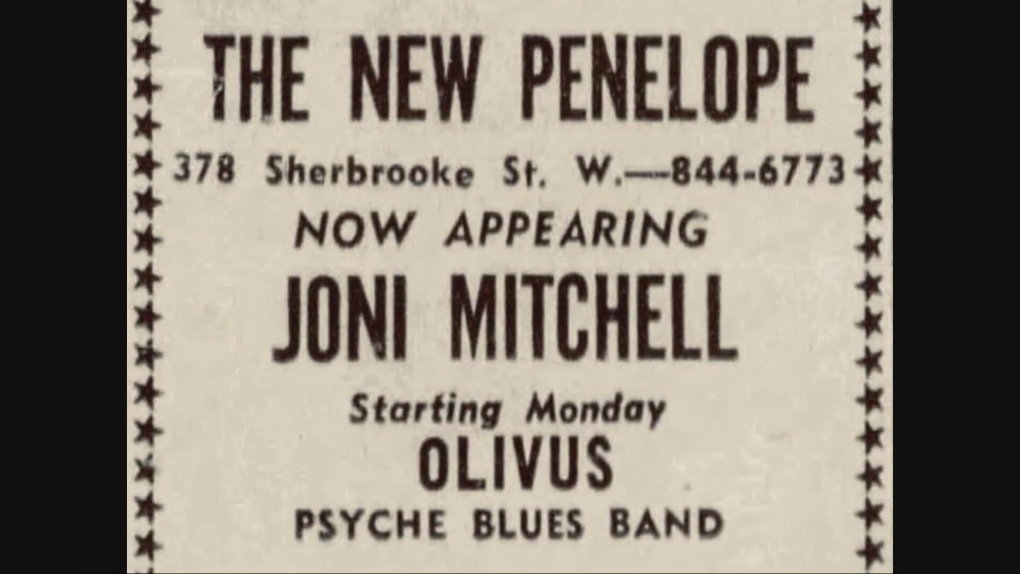The New Penelope: virtual museum pays tribute to 1960s Montreal nightclub
If you were a hip teen or young adult in 1960s Montreal, you might have stepped into several dimly lit downtown spots like the Pot-Pourri on Stanley Street, the nearby Café Andre, or the Finjan Club on Victoria in Côte-des-Neiges with the likes of blues-gospel legend Reverend Gary Davis or a very young Bob Dylan playing in front of young music connoisseurs
Montreal archive centre ARCMTL and its director, Louis Rastelli, delved into this overlooked era of Montreal for the creation of a virtual museum.
"Even in our local history, we have a very baby boomer centric version of the 60s with all the big chapters, the subway, the Expo," said Rastelli, who wasn’t yet born at the time.
"Below the surface, it's just another thing we discovered about the Stanley Street scene. There's all these articles about the Stanley street scene, and nobody thinks of Stanley Street today, but I mean, it was hopping."
 A promotional sign for The New Penelope Club. (Source: Gary Eisenkraft Collection)
A promotional sign for The New Penelope Club. (Source: Gary Eisenkraft Collection)
The big place at the time on Stanley was called the Esquire Showbar, which attracted international jazz and rhythm and blues artists of the time. But it was for adults only.
That’s when a 19-year-old folk singer named Gary Eisenkraft opened the New Penelope Club on Stanley Street above Sainte-Catherine Street. A hole in the wall that could barely seat 60 people. It was an all-ages venue, without a liquor licence.
Rastelli says Eisenkraft's approach to entertainment was ground-breaking at the time, inspired by the emerging counter-culture scene emerging in New York’s Greenwich Village.
"So this guy had the great idea of saying, 'I'm going to bring it to the kids. I'm going to book these amazing bands that none of them are allowed to see now. But I'm going to find a place where they can come and see it,'" Rastelli said.
The initial New Penelope featured local favourites such as the Fugs, the Cavemen, the Sidetracks, or the Mountain City Four, a quartet that included two young sisters named Kate and Anna McGarrigle.
Overwhelmed by its success, the New Penelope moved a few blocks away in 1967 at the corner of Sherbrooke Street and Park Avenue. The interior design was done by famed French artist Francois Dallegret.
There's only one video in existence. It was in a scene shot for a movie called High, shot by avant-garde director Larry Kent, that reflected rebellious youth at the time.
"It wasn’t just about sex. It was sex, drugs and rock and roll, you know," Kent told Rastelli as part of his research on the topic.
For music lovers, the New Penelope was a rare chance to discover up and coming artists.
"That's where you get things like Joni Mitchell and Frank Zappa and Muddy Waters and Penny Lang and Jesse Winchester, Gordon Lightfoot," Rastelli said.
 Montreal archivist Louis Rastelli dug into this overlooked era of Montreal for the creation of a virtual museum. (CTV News)
Montreal archivist Louis Rastelli dug into this overlooked era of Montreal for the creation of a virtual museum. (CTV News)
Pierre Huet, a young author who would help form the Quebec legendary 70s band Beau-Dommage years later, says he came of age at the New Penelope.
"It was really a true experience for me. You know, you consider for me getting into Expo 67 was a major day in my life and getting into the New Penelope," Huet said.
He also recalls that the two solitudes of Quebec at the time got along fine at the café.
"There was absolutely no language barrier inside the club," he said.
Rastelli recently invited the former patrons to a recent gathering to present his online museum. Most are in their 80s now, but their memories are very much alive.
Sam Boskey was a McGill University student at the time, before he became a social activist and municipal city councillor for Montreal.
"It was a time again where there was a discovery of not only of white folk music, but a lot of Black blues, which started to become very popular amongst white audiences. And record companies started to be paying attention to this.
Bluesmen like Muddy Waters, Howlin Wolf, Junior Wells all performed at the cafe," Boskey said.
But the low cover charge, changing tastes, lack of alcohol revenues, and the arrival of a less than peaceful crowd of bikers would soon doom the venue. By the end of 1968, Eisenkraft closed the New Penelope.
"There was a constant job of trying to fend off the creditors because between the bands and the rent, they took a lot of people coming through to be able to make ends meet," Boskey recalled.
Eisenkraft died 20 years ago. But Rastelli now hopes the memory of the New Penelope will be an integral part of Montreal's colourful history.
Rastelli’s online museum of the New Penelope is available on communitystories.ca.
CTVNews.ca Top Stories

opinion Tom Mulcair: Prime Minister Justin Trudeau's train wreck of a final act
In his latest column for CTVNews.ca, former NDP leader and political analyst Tom Mulcair puts a spotlight on the 'spectacular failure' of Prime Minister Justin Trudeau's final act on the political stage.
B.C. mayor gets calls from across Canada about 'crazy' plan to recruit doctors
A British Columbia community's "out-of-the-box" plan to ease its family doctor shortage by hiring physicians as city employees is sparking interest from across Canada, says Colwood Mayor Doug Kobayashi.
'There’s no support': Domestic abuse survivor shares difficulties leaving her relationship
An Edmonton woman who tried to flee an abusive relationship ended up back where she started in part due to a lack of shelter space.
Baseball Hall of Famer Rickey Henderson dead at 65, reports say
Rickey Henderson, a Baseball Hall of Famer and Major League Baseball’s all-time stolen bases leader, is dead at 65, according to multiple reports.
Arizona third-grader saves choking friend
An Arizona third-grader is being recognized by his local fire department after saving a friend from choking.
Germans mourn the 5 killed and 200 injured in the apparent attack on a Christmas market
Germans on Saturday mourned the victims of an apparent attack in which authorities say a doctor drove into a busy outdoor Christmas market, killing five people, injuring 200 others and shaking the public’s sense of security at what would otherwise be a time of joy.
Blake Lively accuses 'It Ends With Us' director Justin Baldoni of harassment and smear campaign
Blake Lively has accused her 'It Ends With Us' director and co-star Justin Baldoni of sexual harassment on the set of the movie and a subsequent effort to “destroy' her reputation in a legal complaint.
Oysters distributed in B.C., Alberta, Ontario recalled for norovirus contamination
The Canadian Food Inspection Agency has issued a recall due to possible norovirus contamination of certain oysters distributed in British Columbia, Alberta and Ontario.
New rules clarify when travellers are compensated for flight disruptions
The federal government is proposing new rules surrounding airlines' obligations to travellers whose flights are disrupted, even when delays or cancellations are caused by an "exceptional circumstance" outside of carriers' control.


































